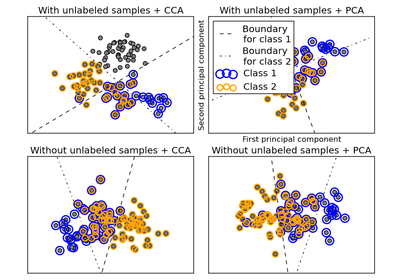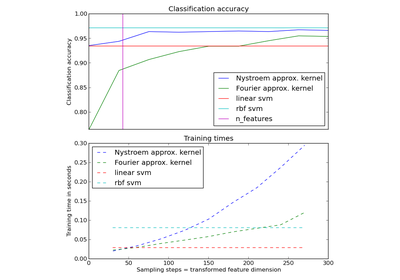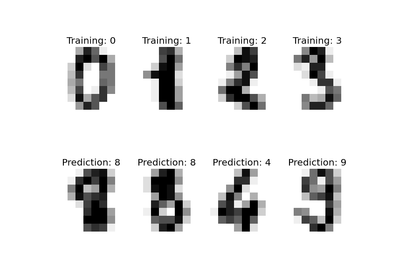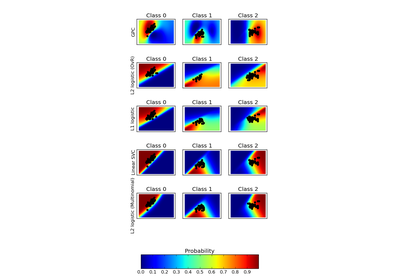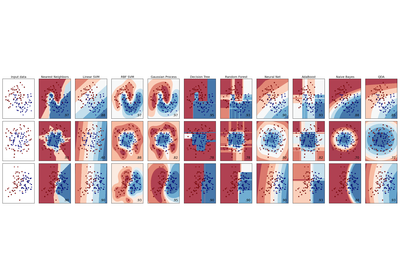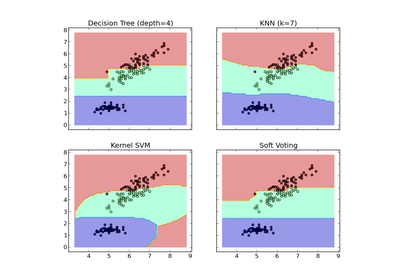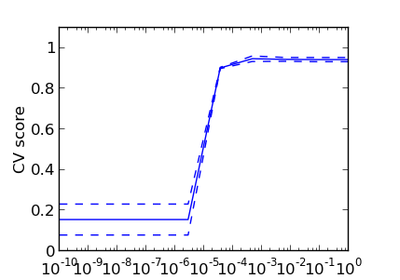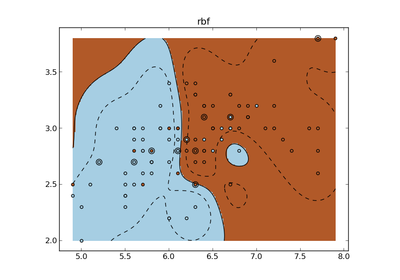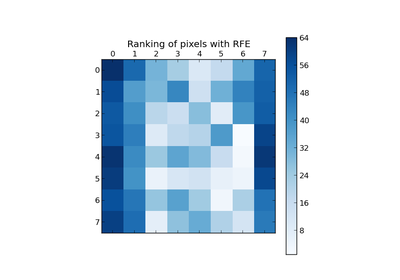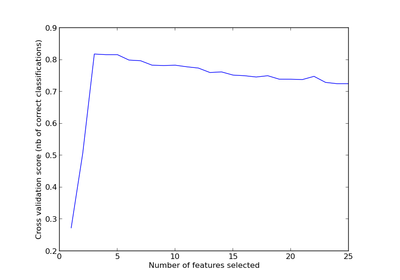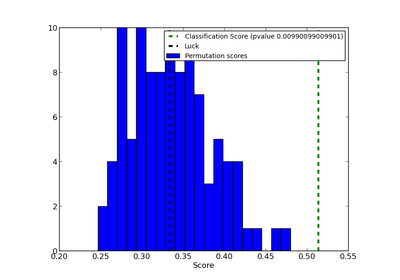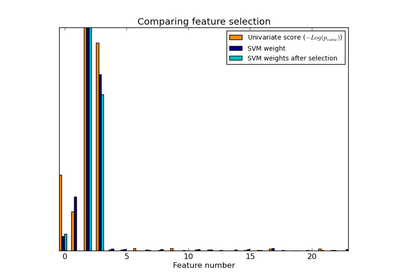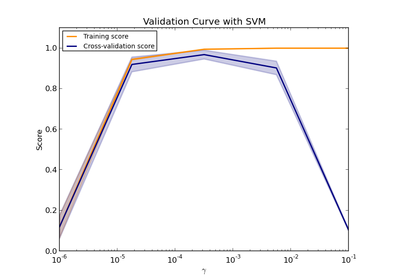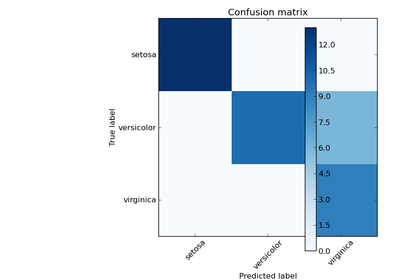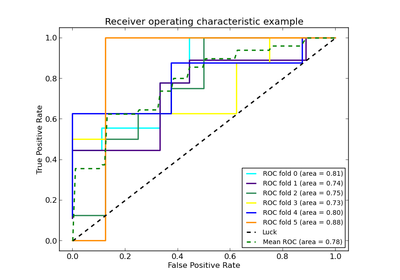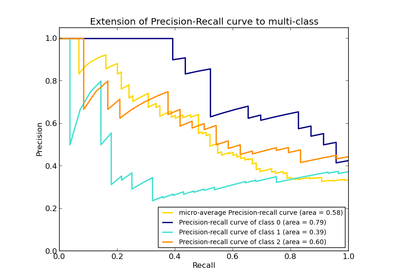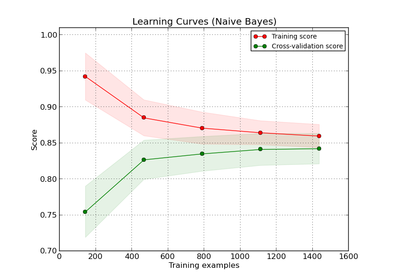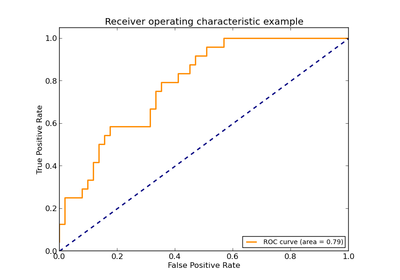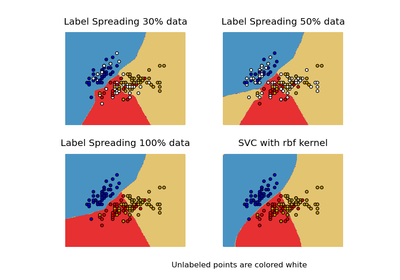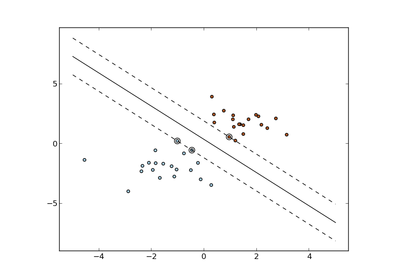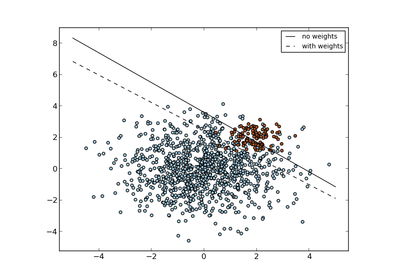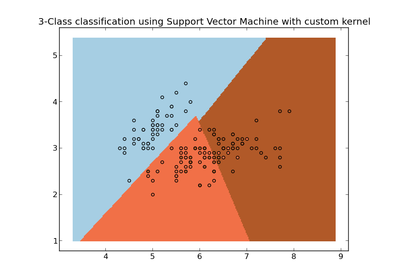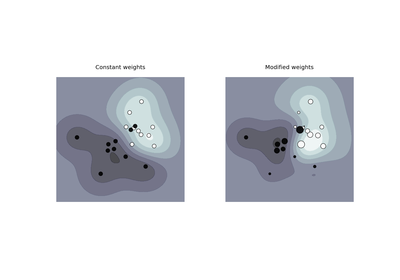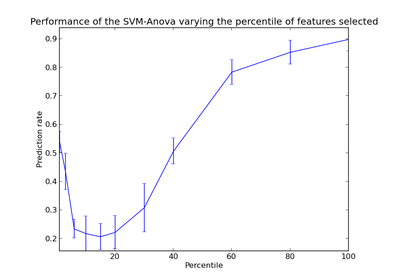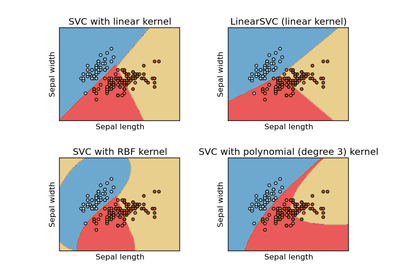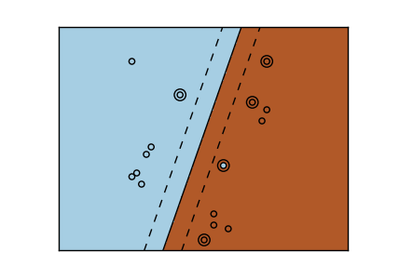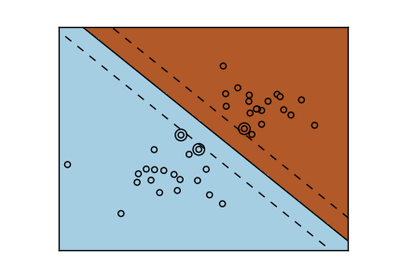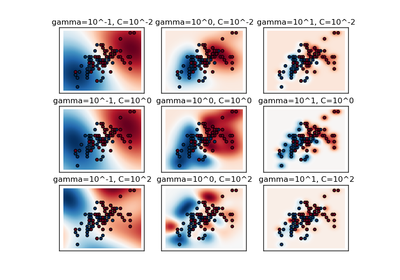sklearn.svm.SVC¶
- class sklearn.svm.SVC(C=1.0, kernel='rbf', degree=3, gamma='auto', coef0=0.0, shrinking=True, probability=False, tol=0.001, cache_size=200, class_weight=None, verbose=False, max_iter=-1, decision_function_shape=None, random_state=None)[source]¶
C-Support Vector Classification.
The implementation is based on libsvm. The fit time complexity is more than quadratic with the number of samples which makes it hard to scale to dataset with more than a couple of 10000 samples.
The multiclass support is handled according to a one-vs-one scheme.
For details on the precise mathematical formulation of the provided kernel functions and how gamma, coef0 and degree affect each other, see the corresponding section in the narrative documentation: Kernel functions.
Read more in the User Guide.
Parameters: C : float, optional (default=1.0)
Penalty parameter C of the error term.
kernel : string, optional (default=’rbf’)
Specifies the kernel type to be used in the algorithm. It must be one of ‘linear’, ‘poly’, ‘rbf’, ‘sigmoid’, ‘precomputed’ or a callable. If none is given, ‘rbf’ will be used. If a callable is given it is used to pre-compute the kernel matrix from data matrices; that matrix should be an array of shape (n_samples, n_samples).
degree : int, optional (default=3)
Degree of the polynomial kernel function (‘poly’). Ignored by all other kernels.
gamma : float, optional (default=’auto’)
Kernel coefficient for ‘rbf’, ‘poly’ and ‘sigmoid’. If gamma is ‘auto’ then 1/n_features will be used instead.
coef0 : float, optional (default=0.0)
Independent term in kernel function. It is only significant in ‘poly’ and ‘sigmoid’.
probability : boolean, optional (default=False)
Whether to enable probability estimates. This must be enabled prior to calling fit, and will slow down that method.
shrinking : boolean, optional (default=True)
Whether to use the shrinking heuristic.
tol : float, optional (default=1e-3)
Tolerance for stopping criterion.
cache_size : float, optional
Specify the size of the kernel cache (in MB).
class_weight : {dict, ‘balanced’}, optional
Set the parameter C of class i to class_weight[i]*C for SVC. If not given, all classes are supposed to have weight one. The “balanced” mode uses the values of y to automatically adjust weights inversely proportional to class frequencies in the input data as n_samples / (n_classes * np.bincount(y))
verbose : bool, default: False
Enable verbose output. Note that this setting takes advantage of a per-process runtime setting in libsvm that, if enabled, may not work properly in a multithreaded context.
max_iter : int, optional (default=-1)
Hard limit on iterations within solver, or -1 for no limit.
decision_function_shape : ‘ovo’, ‘ovr’ or None, default=None
Whether to return a one-vs-rest (‘ovr’) decision function of shape (n_samples, n_classes) as all other classifiers, or the original one-vs-one (‘ovo’) decision function of libsvm which has shape (n_samples, n_classes * (n_classes - 1) / 2). The default of None will currently behave as ‘ovo’ for backward compatibility and raise a deprecation warning, but will change ‘ovr’ in 0.18.
New in version 0.17: decision_function_shape=’ovr’ is recommended.
Changed in version 0.17: Deprecated decision_function_shape=’ovo’ and None.
random_state : int seed, RandomState instance, or None (default)
The seed of the pseudo random number generator to use when shuffling the data for probability estimation.
Attributes: support_ : array-like, shape = [n_SV]
Indices of support vectors.
support_vectors_ : array-like, shape = [n_SV, n_features]
Support vectors.
n_support_ : array-like, dtype=int32, shape = [n_class]
Number of support vectors for each class.
dual_coef_ : array, shape = [n_class-1, n_SV]
Coefficients of the support vector in the decision function. For multiclass, coefficient for all 1-vs-1 classifiers. The layout of the coefficients in the multiclass case is somewhat non-trivial. See the section about multi-class classification in the SVM section of the User Guide for details.
coef_ : array, shape = [n_class-1, n_features]
Weights assigned to the features (coefficients in the primal problem). This is only available in the case of a linear kernel.
coef_ is a readonly property derived from dual_coef_ and support_vectors_.
intercept_ : array, shape = [n_class * (n_class-1) / 2]
Constants in decision function.
See also
Examples
>>> import numpy as np >>> X = np.array([[-1, -1], [-2, -1], [1, 1], [2, 1]]) >>> y = np.array([1, 1, 2, 2]) >>> from sklearn.svm import SVC >>> clf = SVC() >>> clf.fit(X, y) SVC(C=1.0, cache_size=200, class_weight=None, coef0=0.0, decision_function_shape=None, degree=3, gamma='auto', kernel='rbf', max_iter=-1, probability=False, random_state=None, shrinking=True, tol=0.001, verbose=False) >>> print(clf.predict([[-0.8, -1]])) [1]
Methods
decision_function(X) Distance of the samples X to the separating hyperplane. fit(X, y[, sample_weight]) Fit the SVM model according to the given training data. get_params([deep]) Get parameters for this estimator. predict(X) Perform classification on samples in X. score(X, y[, sample_weight]) Returns the mean accuracy on the given test data and labels. set_params(**params) Set the parameters of this estimator. - __init__(C=1.0, kernel='rbf', degree=3, gamma='auto', coef0=0.0, shrinking=True, probability=False, tol=0.001, cache_size=200, class_weight=None, verbose=False, max_iter=-1, decision_function_shape=None, random_state=None)[source]¶
- decision_function(X)[source]¶
Distance of the samples X to the separating hyperplane.
Parameters: X : array-like, shape (n_samples, n_features)
Returns: X : array-like, shape (n_samples, n_classes * (n_classes-1) / 2)
Returns the decision function of the sample for each class in the model. If decision_function_shape=’ovr’, the shape is (n_samples, n_classes)
- fit(X, y, sample_weight=None)[source]¶
Fit the SVM model according to the given training data.
Parameters: X : {array-like, sparse matrix}, shape (n_samples, n_features)
Training vectors, where n_samples is the number of samples and n_features is the number of features. For kernel=”precomputed”, the expected shape of X is (n_samples, n_samples).
y : array-like, shape (n_samples,)
Target values (class labels in classification, real numbers in regression)
sample_weight : array-like, shape (n_samples,)
Per-sample weights. Rescale C per sample. Higher weights force the classifier to put more emphasis on these points.
Returns: self : object
Returns self.
Notes
If X and y are not C-ordered and contiguous arrays of np.float64 and X is not a scipy.sparse.csr_matrix, X and/or y may be copied.
If X is a dense array, then the other methods will not support sparse matrices as input.
- get_params(deep=True)[source]¶
Get parameters for this estimator.
Parameters: deep: boolean, optional :
If True, will return the parameters for this estimator and contained subobjects that are estimators.
Returns: params : mapping of string to any
Parameter names mapped to their values.
- predict(X)[source]¶
Perform classification on samples in X.
For an one-class model, +1 or -1 is returned.
Parameters: X : {array-like, sparse matrix}, shape (n_samples, n_features)
For kernel=”precomputed”, the expected shape of X is [n_samples_test, n_samples_train]
Returns: y_pred : array, shape (n_samples,)
Class labels for samples in X.
- predict_log_proba¶
Compute log probabilities of possible outcomes for samples in X.
The model need to have probability information computed at training time: fit with attribute probability set to True.
Parameters: X : array-like, shape (n_samples, n_features)
For kernel=”precomputed”, the expected shape of X is [n_samples_test, n_samples_train]
Returns: T : array-like, shape (n_samples, n_classes)
Returns the log-probabilities of the sample for each class in the model. The columns correspond to the classes in sorted order, as they appear in the attribute classes_.
Notes
The probability model is created using cross validation, so the results can be slightly different than those obtained by predict. Also, it will produce meaningless results on very small datasets.
- predict_proba¶
Compute probabilities of possible outcomes for samples in X.
The model need to have probability information computed at training time: fit with attribute probability set to True.
Parameters: X : array-like, shape (n_samples, n_features)
For kernel=”precomputed”, the expected shape of X is [n_samples_test, n_samples_train]
Returns: T : array-like, shape (n_samples, n_classes)
Returns the probability of the sample for each class in the model. The columns correspond to the classes in sorted order, as they appear in the attribute classes_.
Notes
The probability model is created using cross validation, so the results can be slightly different than those obtained by predict. Also, it will produce meaningless results on very small datasets.
- score(X, y, sample_weight=None)[source]¶
Returns the mean accuracy on the given test data and labels.
In multi-label classification, this is the subset accuracy which is a harsh metric since you require for each sample that each label set be correctly predicted.
Parameters: X : array-like, shape = (n_samples, n_features)
Test samples.
y : array-like, shape = (n_samples) or (n_samples, n_outputs)
True labels for X.
sample_weight : array-like, shape = [n_samples], optional
Sample weights.
Returns: score : float
Mean accuracy of self.predict(X) wrt. y.
- set_params(**params)[source]¶
Set the parameters of this estimator.
The method works on simple estimators as well as on nested objects (such as pipelines). The former have parameters of the form <component>__<parameter> so that it’s possible to update each component of a nested object.
Returns: self :



